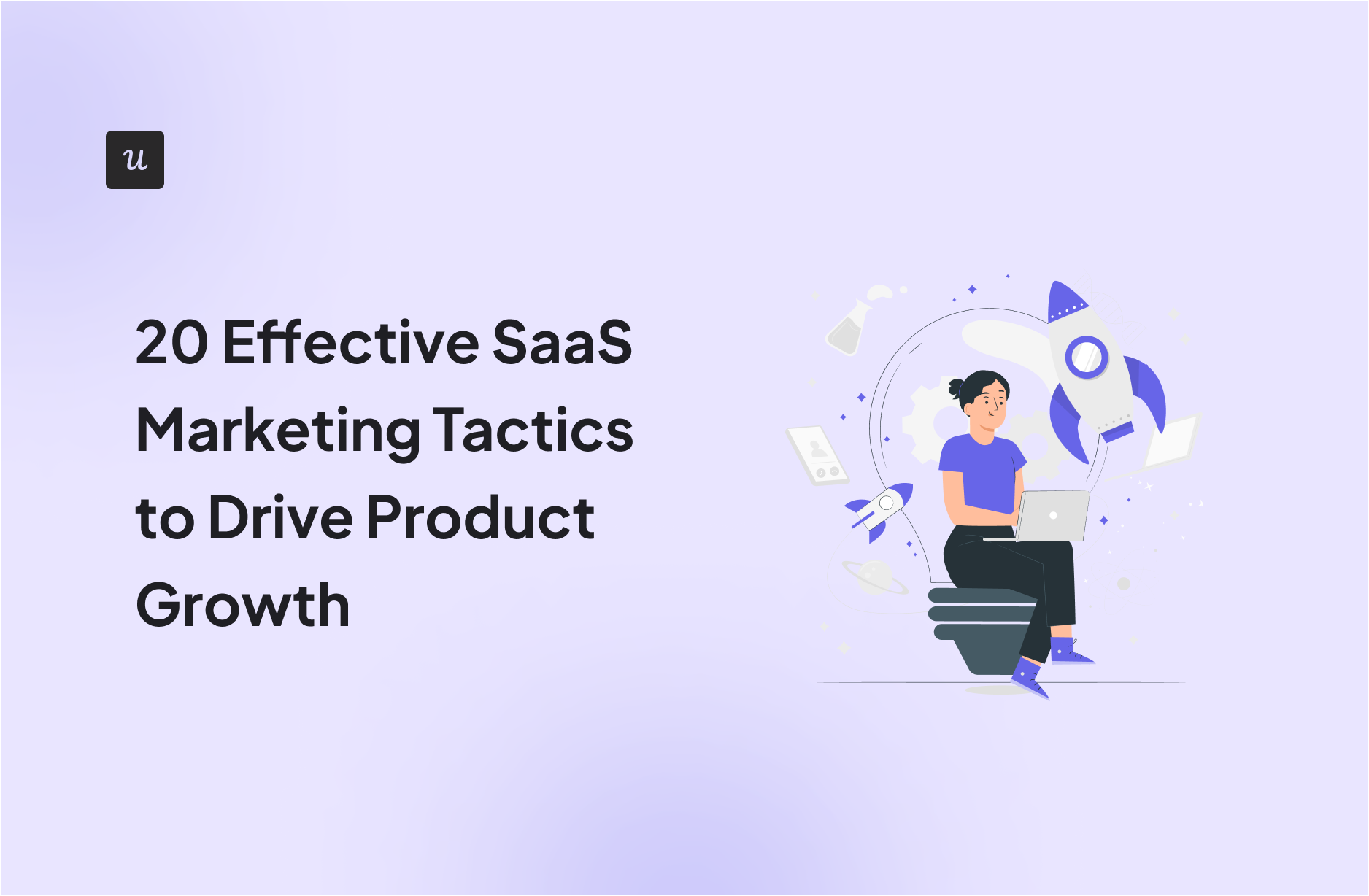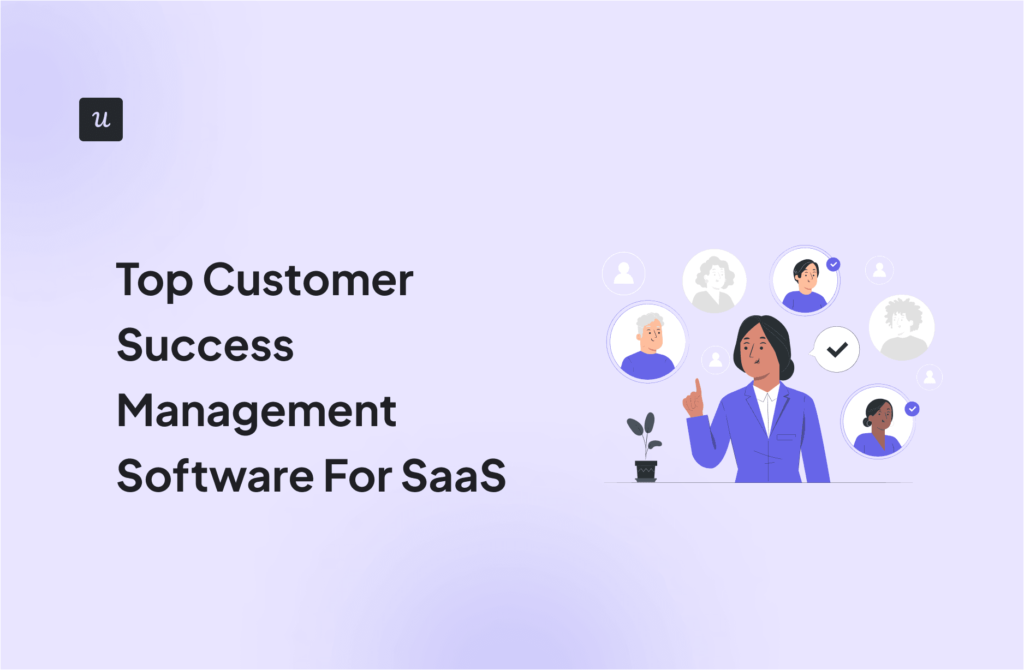
As the SaaS landscape continues to evolve rapidly, choosing the right SaaS marketing tactics will keep you ahead of the curve and on the path to sustainable success.
There is an increased focus on personalization, customer relationships, and targeted messaging as you look to move customers from awareness to consideration to purchase.
In this article, we discuss how to create a SaaS marketing strategy and highlight 20 effective strategies to propel your product marketing efforts and drive your product’s growth this year.
Try Userpilot Now
See Why 1,000+ Teams Choose Userpilot

What is SaaS marketing?
SaaS marketing refers to any marketing strategies and activities subscription-based SaaS companies use to attract leads and convert them into paying customers.
A SaaS marketing plan must also encompass how to retain customers after acquisition.
How to create a B2B SaaS marketing strategy
An effective SaaS marketing strategy considers the needs of your target audience and your product’s key selling points. To be successful, therefore, your plan must include the following steps:
Conduct market research to identify your target audience
The first step in any SaaS marketing plan is knowing who makes up your target market. You need to know what demographic they belong to, their pain points, needs, and behavioral patterns.
To successfully drive them to purchase your product, you also need to know what drives their purchasing patterns and identify the types of content they respond to.
Armed with this information, create buyer and user personas for your different customer types. These hypothetical representations of your ideal customer will help you define your marketing strategies.

Define the product positioning and messaging of your SaaS business
Next, you need to understand your competition and craft a product message that sets your product apart from the competition. This means analyzing your competitors to identify their strengths and weaknesses.
Once that’s done, you’re now poised to create a unique selling proposition (USP) that highlights your product value, sets you apart from other products, and resonates with your target market.
Your USP should be clear, concise, and easy to understand. Whether you choose to highlight your cutting-edge technology or focus on customer success, it needs to be distinct and persuasive.
Choose your marketing channels
Where can you find prospective customers and connect with them? That’s the goal of this next step. Here, the information from your market research will be crucial.
For example, if your product primarily targets the Gen Z audience, social media marketing will have to play a key role in your SaaS marketing strategy. For baby boomers, however, email communication may be preferred.
Of course, depending on your buyer personas, you may also choose to use multiple marketing channels to reach prospective customers.
Create marketing strategies for different channels
Once you’ve decided on your marketing channels, you can now create marketing strategies for each channel within your marketing budget
For instance, for social media marketing, you must identify the specific platforms your ideal customer uses and create a strategy for engaging with them through valuable content and discussions.
You may also consider implementing a content marketing strategy that educates your audience and ranks highly on search engines. Or, you may consider targeted ads to help you reach a wider audience.
Measure the effectiveness of your SaaS marketing strategies and improve
Finally, though, you won’t know if you’ve created an effective SaaS marketing plan if you don’t take the time to track your results.
Use web analytics and marketing tools to measure your campaign’s effectiveness and identify areas for improvement.
As you monitor your results, do not fail to adapt your SaaS marketing strategies to the needs and ideals of your target audience.
20 SaaS marketing tactics for driving growth
Once you know your target customer, unique selling point, and preferred channels, it’s time to craft your SaaS marketing strategy. Consider a few SaaS marketing tactics to get you started.
1. Leverage SaaS content marketing and SEO to reach your target audience
Content marketing is a must for SaaS companies. Potential customers are more likely to adopt products they find while searching for solutions online.
To truly take advantage of this, though, you need to create relevant, high-quality content (blog posts, case studies, etc.) that matches the needs of your audience and showcases your product’s solutions.
You also need to pay attention to search engine optimization (SEO). This involves targeting high-volume, low-competition keywords and optimizing your website performance for mobile and desktop.
For example, the Userpilot blog addresses everything impacting SaaS product growth. In addition to targeting keywords our users may search for, these articles also showcase how our product helps drive growth.

2. Host industry webinars to foster engagement with potential customers
Webinars are a great way to address your target customer’s pain points, showcase your product’s expertise, and provide actionable insights. Live webinars also encourage direct customer interaction and engagement.
The key is to identify relevant topics within your industry. Then, you can collaborate with industry experts to co-host these webinars and attract a larger audience.

It’s also important to properly promote your webinar using various marketing channels and to provide high-quality content with actionable takeaways for attendees.
3. Showcase your SaaS product through strategic video marketing
Video marketing is yet another way to reach your audience. You can create different kinds of videos to reach customers at different stages of the customer journey.
For instance, you can create informational videos that address a major industry pain point and drive awareness. Or, you can create video tutorials that showcase how to use your product’s functionalities for those in the consideration stage.
Similarly, you can adopt different video formats for different platforms. TikTok, for example, is great for short, informational videos. Meanwhile, YouTube is better for detailed long-form videos.

4. Create free helpful tools to raise brand awareness
Also known as the engineering-as-marketing approach, this strategy takes advantage of your problem-solving engineering capabilities to raise awareness and drive lead generation.
It involves creating useful free tools that complement your product or service. In addition to generating organic traffic, these tools provide an opportunity to promote your main product’s features and functions.
For example, Userpilot’s free NPS calculator is a useful tool for those who want to easily and accurately calculate their NPS scores. But it’s also an opportunity to showcase our in-app NPS survey and analytics to visitors who clearly need it.

5. Connect with your potential customers on relevant social media platforms
Whether you’re a B2B or B2C SaaS company, your customers can be found on social media. Your first step is determining the platform(s) your target customers are using (e.g., LinkedIn for B2B SaaS marketing).
Once you do, task your marketing team with creating a strategy for reaching them on the platform. This involves creating shareable content for the platform, engaging in conversations, creating awareness, and responding to messages.
You can also create an online community where users can connect, share knowledge, and support each other; and where you can directly engage with them through group surveys, Q&A sessions, etc.

6. Increase brand awareness with viral growth loops
Growth loops are a SaaS marketing strategy that depends on users’ activities to attract new users. When properly implemented, it reduces your customer acquisition cost and increases your reach.
Because every user helps promote the product, viral loops create a snowball effect that organically boosts awareness. For example, some brands incentivize user-generated content to drive virality.
Calendly, on the other hand, drives virality by adding its brand labels to the free meeting links users share with others. Each usage of its service, thus, becomes a promotion of its brand.

7. Create efficient lead magnets for your SaaS customers
Lead magnets are free items a brand gives away to encourage potential customers to give away their contact details. It involves giving away free but valuable content, such as:
- Ebooks.
- Templates.
- Infographics.
- White papers.
- Certifications, etc.

By creating and giving away valuable solutions, you demonstrate your understanding of your customers’ pain points. You also demonstrate your product’s effectiveness and acquire viable leads on the sign-up form.
8. Nurture and educate leads with email marketing
With a return on investment of about $40 for every dollar spent, email marketing is one B2B SaaS marketing strategy you don’t want to ignore!
You can use it to welcome new users, drive their onboarding, announce updates, and reactivate churned users. You can also send regular emails or newsletters to your subscribers, keeping you top-of-mind and helping you build long-term relationships with potential customers.
For example, here at Userpilot, our newsletter is a valuable read for product marketing experts as it addresses product growth concerns and other related industry trends.

9. Simplify the sign-up flow to remove friction
Once you’ve convinced the customer to take the plunge with you, you don’t want to lose them during the signup process. It’s important, therefore, that you keep the signup flow as simple as possible.
This isn’t the time to collect 3 pages of customer data. Collect the bare minimum needed to get started and ask more questions later (if necessary). You can also include SSO options for easier signup.
Your goal here should be to get the customer to use your product in the shortest possible time. Customizations and personalization can come later.

10. Find opportunities for event marketing
Event marketing can be a powerful tool for SaaS companies, offering a unique opportunity to connect with potential customers on a personal level.
Of course, for this to work, you need to participate in, sponsor, or co-host events within your industry or niche. You must also take the opportunity to collect leads and follow up with them after the event.
For example, Userpilot co-hosts the annual Product Drive conference which brings together product growth enthusiasts as experts discuss all things product marketing and growth.
11. Launch new products and features on Product Hunt
Product Hunt is a hub for tech enthusiasts and early product adopters. This makes it an ideal tool for exposing your product or new feature to a large, relevant audience who need innovative solutions.
A successful Product Hunt launch can attract the right attention and generate even wider media coverage. Product Hunt is also a great source of feedback from potential users.
Of course, not all launches are created equal. When launching on Product Hunt, it’s important that you also generate buzz on social media. You should also approach the platform as a community rather than an ad platform.

12. Get listed on SaaS review sites to gain user trust
According to a study by BrightLocal, over 90% of 18-34-year-olds trust online reviews just as much as personal recommendations.
SaaS review sites, thus, provide an opportunity for you to connect with your target customers and showcase the quality of your SaaS products or services.
The first step is to list your product on review sites like G2 and Capterra, highlighting its features and offerings. Then, you’ll need to encourage (or incentivize) your customers to provide real, honest feedback.
As the number of positive reviews for your product grows on the site, so will your reputation. Prospective customers who find your product on these sites will feel confident to sign up and use your service.

13. Implement referral marketing programs to lower acquisition costs
Referral marketing is one of the best SaaS marketing strategies you can implement. Much like review sites, it harnesses the power of word-of-mouth marketing to help you attract customers and grow your brand.
The trick is to incentivize your current users to bring in new customers in exchange for subscription discounts, free premium features, etc. For even greater chances of success, you can also provide incentives for referees.
Dropbox, for example, has been hugely successful with its referral campaigns. Each successful referral is rewarded with a bonus of 500 MB of free storage space for both the referrer and the referee.

14. Share case studies from successful customers
A good case study showcases the effectiveness of your product and demonstrates your value proposition by showing how others have achieved success with your product.
It highlights the challenges the customer faced, how your product addressed them, and the quantifiable result they achieved.
You can also include direct customer quotes and appropriate data to back up your claim and provide compelling social proof.
For example, this Userpilot case study shows how ClearCalcs improved its new user activation rate with Userpilot’s cohort analysis, reassuring potential customers that success is possible.

15. Demonstrate your product’s features and benefits with live demos
Live demos are a cornerstone of successful SaaS marketing strategies. They enable potential customers to experience your SaaS product firsthand, understand its value proposition, and see how it helps them.
Unlike pre-recorded demos, live demos are interactive and tailored to the specific audience’s needs. A skilled presenter can answer questions in real time and address specific pain points.
A well-executed demo, thus, builds trust and moves prospects down the sales funnel faster. It also provides an opportunity to address common objections and eliminate conversion roadblocks.

16. Offer free trials to generate marketing-qualified leads
Free trials are a staple for SaaS products today. Similar to live demos, free trials and freemium plans offer prospects a chance to experience the product before making a monetary commitment.
To be successful, though, you must ensure that prospects find success during the trial period. This means offering an intuitive onboarding process highlighting your product’s core features and functionalities.

17. Partner with non-competing SaaS companies
Complementary partnerships can be one of the most effective SaaS marketing strategies if properly executed.
For example, Bonjoro, a video engagement platform, tripled its user base when it partnered with ActiveCampaign for its first native integration. The integration enabled users to record and send quick personal videos directly with their ActiveCampaign account.
The partnership, thus, exposed Bonjoro to a wider market of potential customers, while the feature helped ActiveCampaign’s users scale better. A win for both sides.

18. Market new features in-app to drive discovery and adoption
Marketing new features within your existing SaaS application is a powerful strategy for driving user awareness and adoption. Of course, there are many different ways to do this.
For example, you can use non-intrusive tooltips to introduce new features as users navigate a related feature. You can also highlight a feature with temporary badges next to where they appear on the UI.

Or, you can segment your users based on their needs and feature usage, and tailor an in-app notification to alert them to the new feature and its benefits.
Whatever your preferred approach, your goal should be to pique the users’ interest in the feature and ultimately drive adoption.
19. Encourage word-of-mouth marketing among existing customers
Leverage the power of word-of-mouth marketing by encouraging customers to leave reviews on third-party review websites.
One way you can do this is by conducting NPS surveys to determine customer satisfaction levels. Then, you can encourage satisfied customers (promoters) to leave a sincere review on a third-party site.
By fostering a community of happy customers who are incentivized to spread the word, you can amplify your marketing efforts, build credibility, and maximize growth for your SaaS business.

20. Prompt upsells and cross-sells with contextual in-app messages
In the competitive world of SaaS, maximizing customer lifetime value (CLV) is crucial, and upselling (encouraging upgrades) and cross-selling (suggesting complementary products) are key to achieving this.
To be successful, your upselling and cross-selling attempts must be done at the right time. This means sending notifications within the context of user behavior and current activities.
For example, rather than randomly asking users to upgrade their plan, you can trigger an upsell notification when they reach a usage limit or interact with a premium feature.
By identifying relevant upsell opportunities, you improve the product experience for users and make it easy for them to take action and convert.

Conclusion
If implemented strategically, these 20 SaaS marketing tactics can help you navigate the competitive SaaS landscape. Remember, the key lies in understanding your audience and fostering long-term relationships.
Userpilot can help you streamline customer onboarding, launch NPS surveys, and systematically target specific customers based on their in-app behavior. Book a demo to learn more.







